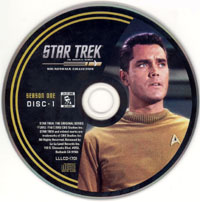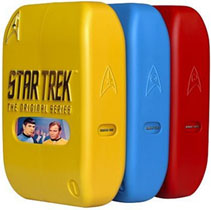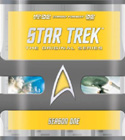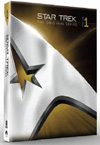The Cage
(Star Trek story #1 in production order)
written and produced by Gene Roddenberry
directed by Robert Butler
music by Alexander Courage
By far the best way to appreciate Star Trek for what it is,
is to start at the beginning.
In other words, let's bypass the networks' misconceptions
about what it needed to be to sell, and their subsequent forcing it to come
out sideways in its broadcast sequence.
Star Trek's first pilot story "The Cage", in its original 63 minute
presentation, is both a contender for the best story of the entire
original series, and one of the most pure statements of vision from
Trek's creator/producer Gene Roddenberry, affectionately known by
cast and crew as the Great Bird of the Galaxy. Indeed, though Roddenberry
shares writing credits on many Star Trek episodes, there are very, very
few that credit him as the sole writer. This is one of those special
episodes that does, and is the best of them by far.
|
|
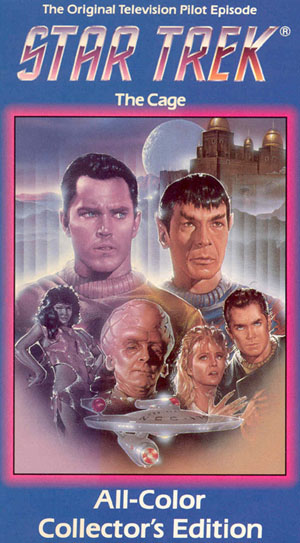
|
You may think you know this one well enough from the other version of it,
the expanded two-part season one adventure
"The Menagerie". Yes, that
presents a lot of the same events and reworks much of the same footage,
but it's a different beast in many important ways. A lot of the excellence
of "The Cage" can only be appreciated in its original form, in the way that
extra scenes add information, drive home the stakes and the themes of the piece,
increase dramatic tensions, and most importantly in how a different
ending may punctuate its primary philosophical message. Much as I like
both versions, "The Cage" is definitely the superior telling of this tale.
Introductory Odyssey
The story's hook is a bit nebulous and non-urgent, but I think it
generally works in this instance - particularly if you set your mind back
and pretend that the entire Star Trek universe is unknown and unfamiliar,
you would want a bit of a gentler way of easing yourself into the
surroundings and customs, as this pilot gives you.
One of the story's earliest strengths is the simple scene in Pike's quarters
between the Captain and the Doctor. The two actors knock this scene out
of the park, and it's a scene that set so much of the tone of Star Trek's
intelligent self-examination and depth of character. It also cleverly
sets up a lot of the backdrops that we will later see in the remainder
of the story. We come out of this scene fully invested in Captain Christopher Pike,
for both his inner and outer struggles.
The story is also pretty smart in beginning by taking us neatly through
an odyssey of all the "real" environments that will be typical for the series
as it moves forward. We get model exteriors of the ship, with an exceptional
lead in to the bridge, and from there we expand to show corridors, crew quarters,
and eventually a conference room. We also get a perfect demonstration of
the transporter as it beams the Captain's landing party down from its special
operating room to the surface of the planet Talos Four. This planet is a bit
more lavish than the eventual norm on this show, since they wouldn't be able
to spend this much time on lighting during a weekly production schedule,
so enjoy the greater production value while it lasts. Nicely, the crew takes
some time to simply explore the setting visually, a section that satisfies
and only lasts as long as it should. And it's not long before
we see some action with fantastic looking phaser blasts, strange looking aliens,
and an all-out set piece brawl, with our gallant captain rescuing a "damsel in distress".
All great exposition for what the Star Trek environment will deliver week after week,
and how it will all work.
Technically, this story primarily has one member of the crew - the captain - trapped
on a planet for the entire episode while his shipmates struggle to rescue him.
Though this may reflect a type of plot that gets overused in many
action-adventure TV shows, including this show and its many spinoffs,
"The Cage" is doing something very special here to mitigate its usual dullness.
We actually wind up seeing the captain in a very wide variety of settings,
each with a different tone and style. Indeed, by the time we come to the end
of this story, it feels as though he's done a better job of getting around
than anyone else on his crew.
Captain Pike's Crew
Because we have now become so accustomed to many different casts and crews
on all the various spinoff Star Trek series, I think it's easier for us now
in retrospect to accept and wholeheartedly go with the very different crew
that is presented to us in this pilot. Jeffery Hunter makes an excellent
captain, and it's easy to see that he could have done a really good job
of leading a series, had he continued on.
Leonard Nimoy is here playing Mr. Spock, who is this story's biggest anchor
for continuity with the rest of the series. He presents a very enjoyable
and watchable character here, though doesn't quite have nailed down all the
personality traits he will later be famous for.
Perhaps the next most familiar to Star Trek fans of all the other actors
present will be Majel Barrett. Here she plays a character known only
as "Number One", a nickname for the second in command of the ship
that Picard will later use for Riker on
"The Next Generation" Star Trek spinoff.
There are a lot of funny theories floating around about why the network
didn't approve this character for the series. A lot has been said in Barrett's
favour about how women should be ready to take command of the ship in the audience's
eyes. Yes, quite a noble and correct cause for Roddenberry to champion, though
perhaps this was just a smokescreen for nepotism that put the network in a position
that was very difficult to successfully defend.
But I think there was perhaps a fatal flaw in the character brief for Number One
to begin with. In terms of what makes people appealing on screen,
it's much easier to get away with a male character maintaining attractiveness
while showing no emotion. Indeed, Pike certainly isn't very jolly or exuberant in
this one, yet he is still very likeable. But I think if you want to make a female
character appealing enough to be the second lead of a TV series, attracting
as wide an audience as possible, you don't want her to be emotionally shut down
and inexpressive. If you ask for it, you can get a good actress like Barrett
to absolutely nail the character, and it still won't be enough to give nervous
executives the confidence to take a chance on it as a series staple. Perhaps
they knew this in their guts without knowing how to articulate it. I don't think
Number One was dropped because she was a woman in command - indeed I absolutely
love the scenes of her in charge of the crew, leading the rescue efforts and
thinking through all the steep challenges. I think dropping the character had much
more to do with her being a female lead devoid of emotional expressiveness by design,
and on those grounds the character makes a better guest star than a regular.
Star Trek eventually made the smarter move of giving the unemotional aspects
to Mr. Spock, while Nimoy worked hard to ensure that it remained interesting
and attractive to the audience.
Another very good castmember here is John Hoyt playing Dr. Philip Boyce. I liked
this character a lot and wish we could have seen more of him in a continuing series.
Susan Oliver made an excellent guest star for this pilot, playing a character
with a wide range of dramatic points and an equally wide range of different looks.
It is perhaps a bit of a shame that it isn't until the reveal of her final secret
at the end that the audience can truly see how well-rounded her character has
been the whole time... meanwhile many women in the audience may be rolling
their eyes with incredulity. Meg Wyllie is also a very critical member of the cast
in making this show a success, as she brings the very alien Keeper to life,
with a little help from Malachi Throne's electronically processed voice.
A very successful combination.
I liked Laurel Goodwin as the Yeoman in this one - it would have been fun to see
further shenanigans from this character. She's a good foil for Hunter's captain,
and I'm sure I would have enjoyed any further scenes played for humour between
those two. A lot of the other characters seem to be homogenous variations
on over-eager American enlisted men - war films often seem to be overpopulated
with these types. Of the lot, Peter Duryea's Lt. José Tyler
stands out as the most memorable and perhaps most archetypal - for sure something
good could have been made of his character if the series had followed the
modern spinoff's practice of rotating main protagonist status amongst a large
cast during various episodes. However, this didn't happen much in 1960's Star Trek,
and I'm not sure the character could attract much attention if left as background
support.
Believe it or not, Spock isn't the only crewmember in this story to continue into the
series. Geological Technician Fisher, played by Ed Madden, will be back for
another episode or two before too long as well, but you'll have to keep your eyes
peeled, and prepare to look beyond a slight alteration of his hair....
Razzamatazz...
The high production values of this pilot, compared with the rest of the series,
help it stand out and above many other episodes. Nicely, there is enough budget
to make the laser beams present and impressive as a lot of enjoyably colourful effects
are painted onto the screen, with enough sound effects and energy to create
some breathtaking spectacle. Very good. We also get a surprisingly wide variety
of environments as visual eye-candy. The sound effects team are also hard at work
creating the standard library that we will come to enjoy and celebrate
as part of this show's auditory signature.
One of the production's great oddities is that all of the nice model shots
of the Enterprise are crammed into either the title sequence or the end credits.
We don't see anything of the ship as it enters or exits Talosian orbit,
and though there seems to be an open spot for a few more shots in the edit
as they decide to answer the distress call, we get nothing but empty space
with characters' faces superimposed. Weird. Even if they had to re-use some shots,
either flipped left-to-right for variety or left as is, it would have been good
to have stuck them in.
|
And of no small import is Alexander Courage's triumphant musical score,
easily the most impressive and varied of the four he did for the show's
first season. This story marks the debut of the mystical tinkling call of space,
followed by the triumphant answer of Star Trek's signature opening fanfare
that represents the best of the human spirit. Then follows the 1960's
adventurous swinging title theme, which receives the most sympathetic vocal
performance here that it will ever get, as these same vocal qualities extend
other-worldliness to many of the other individual cues of the story.
There are many other great highlights to this highly melodic score,
but perhaps my favourite is the very strangely orchestrated Talosian Theme
which debuts near the end of "The Survivors" and features Jack Cookerly's
self-built electronic guitar. Most cool, and quickly going on to become
another signature Trek sound.
|
|
|
Optimism in Action
The ending for this story is both a blessing and a bit of trouble. The trouble
is that it doesn't quite escalate its levels of drama, excitement, and energy
high enough to deliver a definitive final challenge for Pike and company to
overcome. There is some good tension and threat (and more in "The Cage" version
than in "The Menagerie" version), as Pike frees himself and his
friends from incarceration, and earns some respect from his adversaries,
but no, it isn't the brawl or shootout or chase that we might all instinctively
get invested in, were this a good action episode of a western.
There's a bit of a downbeat here as well, with the now sympathetic Talosian society
looking as though it's headed for extinction, and Vena resigning herself from
participation in reality.
But I think the positives on display here get their due in terms of cinematic
and musical moments, and eventually shine stronger. Captain Pike has been
learning and adapting all through this adventure, and stays focused enough
that he can eventually see through his adversaries' illusions and outsmart them
to gain his freedom. We also see him and his second in command negotiate their way
to a peaceful solution
and come to an understanding with their adversaries - a most noble Trekkian staple -
and this episode's version of that is particularly organic in the way that it develops.
This conclusion eventually sees all the characters celebrating
Infinite Diversity in Infinite Combinations, a very good ideal to promote
on-screen in the pilot. Very well done.
This pilot story is also quite vocal with its theme of illusions and fantasy
versus reality, offering a lot of good dialogue on the subject,
and examining some of the long-term ramifications and dangers.
I always particularly loved the strong statements for preferring reality over fantasy,
which feel particularly inspirational. At the end of this one,
Pike chooses his hard won reality, and that felt like the correct
conclusion for this highly enjoyable story.
In later years, I realized I'd missed a more subtle layer here. In actual fact,
Roddenberry has put in a few good words for fantasy as well, not least of all
since Pike's forced indulgence in it has somewhat cured his disillusionment
for his life and career, and put him back on the path to embracing both
more wholeheartedly. Perhaps the fantasy part of the argument hasn't quite
been hit on the head as directly or with as much power, but it remains key
to appreciating the balance of the ending. Vena and the Talosians choose
fantasy, and the Keeper signs off by noting how they've all chosen different
things, continuing to enjoy infinite diversity. "May you find your way as pleasant,"
he offers. Very nice formula for cultures to maintain their richness and
find peace with each other. VERY Trek. I'll have that over a bout
of fisticuffs any day.
Yes, this 63 minute cinematic story is a classic, not just for Star Trek,
but also for television and cinema, and nicely for its primary genre as well.
"The Cage" embraces a very strong identity as science fiction,
and rises to be one of sci-fi's most excellent gems,
demonstrating how television can do the genre right.
Kudos to all those who participated in bringing this fine piece of art to life.
Read the next Star Trek review:
"Where No Man Has Gone Before"
|
|








